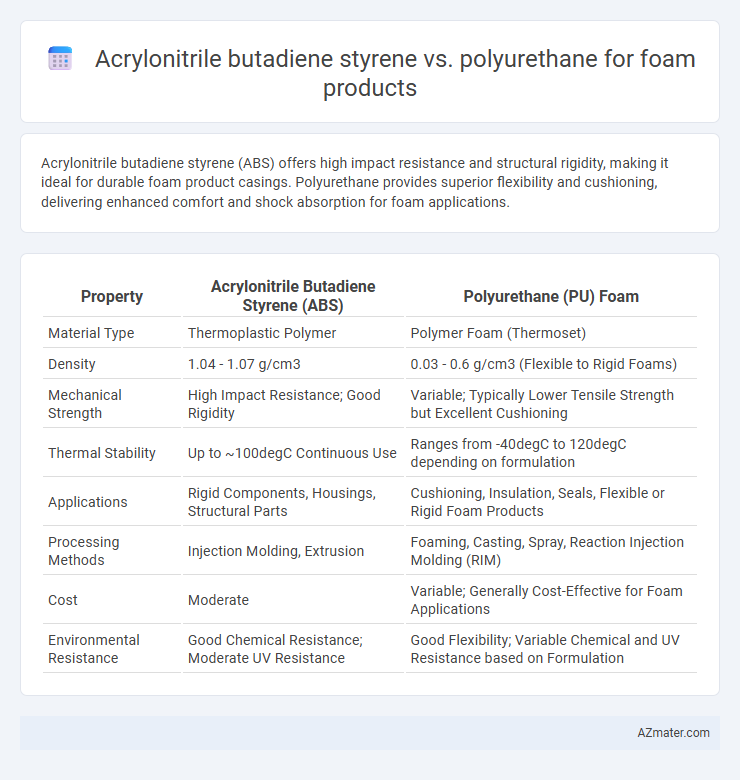Acrylonitrile butadiene styrene (ABS) offers high impact resistance and structural rigidity, making it ideal for durable foam product casings. Polyurethane provides superior flexibility and cushioning, delivering enhanced comfort and shock absorption for foam applications.
Table of Comparison
| Property | Acrylonitrile Butadiene Styrene (ABS) | Polyurethane (PU) Foam |
|---|---|---|
| Material Type | Thermoplastic Polymer | Polymer Foam (Thermoset) |
| Density | 1.04 - 1.07 g/cm3 | 0.03 - 0.6 g/cm3 (Flexible to Rigid Foams) |
| Mechanical Strength | High Impact Resistance; Good Rigidity | Variable; Typically Lower Tensile Strength but Excellent Cushioning |
| Thermal Stability | Up to ~100degC Continuous Use | Ranges from -40degC to 120degC depending on formulation |
| Applications | Rigid Components, Housings, Structural Parts | Cushioning, Insulation, Seals, Flexible or Rigid Foam Products |
| Processing Methods | Injection Molding, Extrusion | Foaming, Casting, Spray, Reaction Injection Molding (RIM) |
| Cost | Moderate | Variable; Generally Cost-Effective for Foam Applications |
| Environmental Resistance | Good Chemical Resistance; Moderate UV Resistance | Good Flexibility; Variable Chemical and UV Resistance based on Formulation |
Introduction to ABS and Polyurethane in Foam Products
Acrylonitrile butadiene styrene (ABS) is a thermoplastic polymer known for its durability, impact resistance, and ease of molding, making it suitable for rigid foam applications where structural integrity is essential. Polyurethane foam offers excellent flexibility, cushioning, and insulation properties, widely used in seating, bedding, and thermal insulation products. Both materials serve distinct functions in foam products, with ABS providing hardness and strength, while polyurethane contributes to softness and comfort.
Material Composition: Acrylonitrile Butadiene Styrene vs Polyurethane
Acrylonitrile Butadiene Styrene (ABS) is a thermoplastic polymer composed of acrylonitrile, butadiene, and styrene, offering rigidity and impact resistance ideal for structural foam applications. Polyurethane, a polymer formed by the reaction of polyols and isocyanates, provides superior flexibility, excellent cushioning, and chemical resistance suitable for soft foam products. The material composition difference fundamentally affects the foam's durability, flexibility, and suitability for specific industrial uses.
Mechanical Strength and Durability Comparison
Acrylonitrile butadiene styrene (ABS) exhibits superior impact resistance and higher tensile strength, making it ideal for applications requiring mechanical robustness. Polyurethane foam, while offering excellent flexibility and cushioning properties, generally has lower mechanical strength but excels in durability against wear and environmental factors such as moisture and abrasion. The choice depends on whether rigidity and structural integrity (favoring ABS) or resilience and comfort (favoring polyurethane) are prioritized in the foam product.
Flexibility and Resilience in Foam Applications
Acrylonitrile butadiene styrene (ABS) offers moderate flexibility and good impact resistance but lacks the high elasticity found in polyurethane foams, making it less suitable for applications requiring significant deformation and recovery. Polyurethane foam exhibits superior flexibility and resilience due to its cellular structure, enabling excellent compression set resistance and rapid recovery after deformation in cushioning and padding applications. The choice between ABS and polyurethane foam depends on the required balance of rigidity versus elastic recovery, with polyurethane preferred for high-flexibility, resilient foam products.
Thermal and Chemical Resistance Differences
Acrylonitrile butadiene styrene (ABS) exhibits moderate thermal resistance with a glass transition temperature around 105degC, making it suitable for applications requiring impact resistance and rigidity under moderate heat. Polyurethane foam demonstrates superior chemical resistance and thermal insulation properties, maintaining stability across a broader temperature range from -40degC to 120degC, which enhances its performance in aggressive chemical environments. The inherent structural differences result in ABS being less resistant to solvents and corrosive chemicals, whereas polyurethane's cross-linked polymer matrix provides enhanced durability against thermal degradation and chemical exposure in foam products.
Manufacturing Processes for ABS and Polyurethane Foams
Acrylonitrile butadiene styrene (ABS) is typically manufactured through injection molding, which provides precise control over dimensions and produces rigid, durable foam products with good impact resistance. Polyurethane foam production involves a chemical reaction between polyols and isocyanates, often utilizing reaction injection molding (RIM) or slabstock processes that create flexible or rigid foams depending on formulation and curing conditions. Manufacturing ABS foam emphasizes thermoplastic extrusion and molding techniques, while polyurethane foam production relies heavily on controlled polymerization and foaming reactions to achieve desired cellular structures and mechanical properties.
Cost Efficiency and Availability
Acrylonitrile butadiene styrene (ABS) offers moderate cost efficiency due to its widespread availability and well-established manufacturing processes, making it a budget-friendly choice for foam products in large-scale production. Polyurethane foam typically incurs higher material and processing costs but delivers superior cushioning and durability, justifying its premium pricing in applications demanding enhanced performance. ABS benefits from extensive global supply chains, while polyurethane's availability can vary depending on the specific formulation and required density, influencing lead times and overall cost efficiency.
Environmental Impact and Sustainability
Acrylonitrile butadiene styrene (ABS) foam products contribute to environmental concerns due to their reliance on non-renewable petroleum resources and challenges in recycling, resulting in persistent plastic waste. Polyurethane foam offers better sustainability prospects with advancements in bio-based polyols and improved recyclability, reducing its carbon footprint and landfill burden. Choosing polyurethane foam enhances eco-friendly product life cycles by integrating renewable materials and supporting circular economy practices.
Common Uses: ABS Foam vs Polyurethane Foam
ABS foam is commonly used for lightweight, impact-resistant applications such as automotive parts, protective gear, and electronic housings due to its rigidity and durability. Polyurethane foam excels in cushioning, insulation, and packaging, frequently utilized in furniture padding, mattresses, and thermal insulation panels because of its flexibility and excellent shock absorption. ABS foam provides structural strength, while polyurethane foam offers superior comfort and thermal properties in foam product applications.
Choosing the Right Material: Key Considerations
Acrylonitrile butadiene styrene (ABS) offers high impact resistance and rigidity, making it ideal for structural foam applications requiring durability and dimensional stability. Polyurethane foam excels in flexibility, cushioning, and insulation properties, suitable for comfort-focused products and thermal protection. Key considerations include mechanical stress tolerance, thermal resistance, and specific use-case demands to determine the optimal material choice for foam products.

Infographic: Acrylonitrile butadiene styrene vs Polyurethane for Foam product
 azmater.com
azmater.com